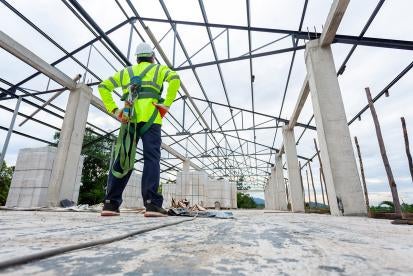The White House has announced long-awaited final guidance to federal agencies to implement domestic content and manufacturing requirements in federally funded infrastructure projects. The Biden administration guidance applies broadly to the use of iron, steel, and other common construction materials and products and, as a result, is expected to have broad implications for awardees of federal funding, prospective applicants, contractors, and suppliers.
Background
On November 15, 2021, President Biden signed into law the Infrastructure Investment and Jobs Act (IIJA) (P.L. 117-58), which includes the Build America, Buy America Act (BABA) requiring infrastructure projects receiving IIJA funding and other federal financial assistance to utilize certain domestically produced materials, including iron or steel products, manufactured products, and construction materials (“the BABA requirements”).
On August 23, the Office of Management and Budget (OMB) published final guidance to federal awarding agencies on BABA’s requirements in the Federal Register. The final guidance follows initial implementation guidance published by OMB in Memorandum M-22-11 in April 2022.
Scope and Applicability
Section 70915(a) of BABA requires OMB to issue guidance to federal agencies to facilitate the implementation of the BABA requirements and permits OMB to amend Subtitle A of title 2 of the Code of Federal Regulations (CFR) to ensure federal agencies enforce the BABA requirements through conditions of federal financial assistance awards. In its final guidance, OMB notes its amendments to the CFR are intended as “high-level coordinating guidance” to agencies. In addition, OMB indicates throughout the final guidance that federal agencies are responsible for the direct implementation of BABA and may issue additional, agency-specific guidance. In some federal agencies, that process of developing BABA guidance and regulations is well underway. On August 16, the US Department of Transportation issued a notice finalizing a limited public interest waiver of Buy America requirements for de minimis costs (total value of the non-compliant products is no more than the lesser of US$1million or 5% of total applicable project costs) and small grants (total federal financial assistance to the project is less than $500,000).
Federal Financial Assistance and For-profit Entities
BABA requirements apply to all awards of federal financial assistance for infrastructure projects in the US, notwithstanding whether the awardee receives funding from the IIJA or other statutory sources. Therefore, the BABA requirements will apply to awards of federal financial assistance for infrastructure projects provided under existing programs, including loans made under the Transportation Infrastructure Finance and Innovation Act (TIFIA) and the Water Infrastructure Finance and Innovation Act (WIFIA) programs, as well as newly created programs, such as programs under the CHIPS and Science Act and Inflation Reduction Act (IRA), with certain exceptions.
For example, the BABA requirements will apply to awards under the IRA’s Neighborhood Access and Equity (NAE) grant program, which provides approximately US$3.1 billion in grants to remediate and mitigate the impacts of dividing or burdening surface transportation projects, as part of the broader Reconnecting Communities and Neighborhoods (RCN) combined funding opportunity released on July 5, 2023.
Under BABA, Congress adopted the existing definition of “federal financial assistance” found in 2 CFR § 200.1. As a result, the BABA requirements apply to the award of federal grants, cooperative agreements, direct appropriations, loans, loan guarantees, and certain other forms of financial assistance to non-federal entities, where non-federal entities are defined as states, local governments, territories, tribes, higher education institutions, or nonprofits. Accordingly, the final guidance does not include for-profit entities in the definition of non-federal entities for the purposes of BABA, thus federal assistance awarded directly to for-profit entities is not covered by this guidance. However, in response to public comments, OMB indicated that federal agencies may impose certain existing domestic procurement preferences found at 2 CFR § 200.322 on for-profit entities.
Infrastructure Projects
OMB defined infrastructure to include public infrastructure projects in the US, including “structures, facilities, and equipment” for surface, maritime, and public transportation, freight and passenger rail, water and wastewater systems, broadband, and electricity transmission and generation, among others. Moreover, OMB has instructed federal awarding agencies to construe the term infrastructure broadly.
Notably, the BABA requirements apply “regardless of whether infrastructure is the primary purpose of the Federal award.” We anticipate that federal agencies, in deciding whether BABA’s requirements should apply to any infrastructure component of a given program, will heed OMB’s direction to interpret “infrastructure” broadly.
In addition, OMB revised its initial guidance to reflect that the BABA requirements apply to articles, materials, or supplies that are “permanently incorporated into” infrastructure projects rather than “used in the project.” OMB further noted these changes confirm the BABA requirements do not apply to temporary structures, such as scaffolding, as well as tools and equipment brought to worksites.
Effective Date
The final guidance is effective 60 days following publication in the Federal Register, and therefore will apply to awards of federal financial assistance obligated on or after October 23, 2023. Awards of federal financial assistance obligated after May 14, 2022, and prior to October 23, 2023 will instead be subject to OMB’s initial implementation guidance found within OMB Memorandum M-22-11.
The final guidance also provides for a transition period that shields certain infrastructure projects with multiple federal funding obligations from being subject to new provisions in the final guidance. Specifically, the final guidance provides that projects awarded federal financial assistance between May 14, 2022, and October 23, 2023 continue to be subject to OMB’s initial implementation guidance only, even if the infrastructure project receives an additional federal financial assistance obligation after the effective date of the final guidance. However, federal award agencies may apply the final guidance to the new award of financial assistance where “significant design or planning changes are made to the infrastructure project.” As a result, recipients of multiple federal funding awards should be mindful that major changes to infrastructure projects could result in different BABA requirements governing the projects.
Reconciling With Existing Buy America Requirements
Many federal agencies and federal funding programs maintain longstanding domestic content and manufacturing requirements. Under Section 70914 of BABA and proposed Section 184.2(a) of the final guidance, the requirements created by BABA and implemented by federal agencies do not apply to preexisting Buy America standards that meet or exceed BABA’s requirements. However, agencies must adopt provisions of BABA where comparable standards or categories are not in place. For instance, the final guidance notes that Congress created Buy America requirements for construction materials – a category of materials largely not subject to Buy America standards under federal law.
Many of the pre-BABA Buy America requirements were established by regulation; changes to those regulations can take many months, if not years, to finalize. That work is underway at federal agencies.
Classification of Materials
Section 184.4(e) offers guidance on the classification of articles, materials, or supplies under BABA’s covered categories. The final guidance clarifies that articles, materials, or supplies should only be classified into one of BABA’s covered categories – iron or steel products; manufactured products; construction materials; or stone, sand, gravel, or aggregate. Importantly, the guidance provides that the classification of an article, materials, or supply should be based on its status at the time that it is brought to a worksite.
Requirements for Types of Materials
Predominantly Iron and/or Steel Products
The final guidance defines iron or steel products as “articles, materials, or supplies that consist wholly or predominantly of iron or steel or combination of” iron and steel. To meet the definition of “produced in the US,” all manufacturing processes for iron or steel products must occur in the United States, including processes from initial melting to the application of coatings. “Predominantly” is defined as greater than 50% by cost.
Definition of Manufactured Products
While the final guidance simply re-states the statutory “produced in the United States” standard for manufactured goods,1 the guidance does affirmatively define manufactured products as “articles, materials, or supplies that have been:
i. processed into a specific form and shape; or
ii. combined with other articles, materials, or supplies to create a product with different properties than the individual articles, materials, or supplies.”
To clarify the requirement that greater than 55% of components must be produced in the US, the guidance includes instructions to calculate the cost of a manufactured product’s components, based on the existing “cost of components” test found in the Federal Acquisition Regulation (FAR). Section 184.5 provides further details on determining the cost of components, including separate instructions for purchased and manufactured components. In general, award recipients are required to compare the value of components manufactured in the US to the total cost of all components in the manufactured product. Where the value of US components exceeds 55% of the total value of the manufactured product, that product is deemed to comply with BABA.
The guidance further clarifies that items that otherwise meet the definition of iron or steel products, construction materials, or stone, sand, gravel, and aggregate materials cannot be considered manufactured products, and therefore be subject to the less stringent cost-of-components standard. However, the guidance notes that manufactured products may nevertheless contain components that themselves would meet the definition of another type of material. For example, a door made of engineered wood would be considered a manufactured product even though engineered wood itself is a construction material.
Construction Materials
OMB defines construction materials as follows, “The listed items are:
i. Non-ferrous metals;
ii. Plastic and polymer-based products (including PVC, composite building materials, and polymers used in fiber optic cables);
iii. Glass (including optic glass);
iv. Fiber optic cable (including drop cable);
v. Optical fiber;
vi. Lumber;
vii. Engineered wood; and
viii.Drywall.”
While the list of construction materials is largely consistent with BABA’s text and prior guidance, the list includes materials not previously identified by Congress in BABA’s findings –fiber optic cable, optical fiber and engineered wood. The guidance justifies the addition of the new materials based on their relationship with previously identified materials. For example, OMB notes fiber optic cables are composed of both plastic and polymer-based products and optic glass. Notably, OMB declined to include bricks, paint, and coatings within the definition of construction materials. However, OMB indicated it may consider additions to the list of construction materials in future guidance.
In addition, OMB provides additional guidance on the application of coatings, materials, and other minor additions to construction materials. Under the definition of construction material, the guidance clarifies that “minor additions of articles, materials, supplies, or binding agents” do not alter the characterization of construction materials. As such, the application of a coating or other minor addition would not render a construction material a manufactured product and thus afford the less stringent “produced in the US” standard. To meet the BABA requirements for construction materials, all manufacturing processes for the materials must occur in the US. In proposed Part 184.6, OMB provides specific standards for “produced in the United States” for each of the construction materials. For example, for plastic and polymer-based products, all manufacturing processes must occur in the US, including initial combination of plastic or polymer-based inputs. This is a meaningful change, from the April 2022 OMB memorandum, in the definition of “produced in the Unites States” for construction materials. Where the memorandum provided that only the final and immediately preceding manufacturing processes must take place in the US, this final guidance now requires all manufacturing processes to be domestic.
Stone, Sand, Gravel, and Aggregate Materials
Section 70917(c) of BABA provides that stone, sand, gravel, and aggregate materials are not construction materials for the purpose of BABA. OMB’s final guidance also provides additional information on these materials, referred to as Section 70917(c) materials. Importantly, the guidance maintains that stone, sand, gravel and aggregate materials are not manufactured products, nor should they be treated as manufactured products when they are mixed or used near or on the work site. For instance, cement that is mixed with aggregate into concrete on the worksite should not be considered a manufactured product.
Nevertheless, OMB clarified that Section 70917(c) materials may, in certain instances, meet the definition of components of manufactured products. For example, manufactured precast concrete that is transported to the worksite would be considered a manufactured product under BABA, despite the precast concrete containing cement and aggregates. In this example, the precast concrete must be manufactured in the US and more than 55% of the cost of the precast concrete’s components must be manufactured in the U S.
Waiver Process
OMB’s final and initial implementation guidance devotes significant attention to the Buy America waiver process. BABA Section 70914(b) provides for three types of waivers to the Buy America preference– (i) public interest, (ii) unreasonable cost and (iii) nonavailability waivers. The final guidance restates the three categories of waivers and provides instructions on proposing and issuing waivers, which apply to all federal agencies. Waiver requests must be submitted to a federal awarding agency in writing, subject to agencyspecific requirements for format, contents and supporting documentation. Before issuing or denying a waiver, federal agencies must prepare a detailed written justification for its action. The agency’s written justification must be publicly available, subject to public comment, and submitted to OMB’s Made in America Office for final review.
OMB has signaled a desire for agencies to rely on the BABA waiver process to address a range of concerns arising from the application of the BABA requirements, including supply chain and compliance concerns. For instance, OMB suggests federal agencies utilize the waiver process to provide relief to parties impacted by OMB’s revised guidance, including the addition of fiber optic cables, optical fiber, and engineered wood to the definition of construction materials. In addition, OMB has indicated the waiver process is the appropriate forum to address concerns relating to specific foreign sources of materials, such as Canadian softwood lumber.
Future Agency and OMB Guidance
Manufacturers and contractors – as well as awardees of federal financial assistance – should monitor for agency revisions to existing Buy America programs to bring them in line with BABA, as well as other efforts to implement BABA requirements, such as the US DOT public interest waiver mentioned above. For example, BABA requires agencies to periodically review all existing general applicability waivers, and the Federal Highway Administration has a review underway of its 1983 Buy America general waiver for manufactured products.
Finally, OMB intends – prior to October 23, 2023 – to issue an updated memorandum to replace the April 2022 Memorandum and “remove direct conflicts between Memorandum M-22-11 and the revised guidance in part 184.”
- “Produced in the United States means: … (2) In the case of manufactured products: (i) The product was manufactured in the United States; and (ii) The cost of the components of the manufactured product that are mined, produced, or manufactured in the United States is greater than 55 percent of the total cost of all components of the manufactured product, unless another standard that meets or exceeds this standard has been established under applicable law or regulation for determining the minimum amount of domestic content of the manufactured product. See § 184.2(a). The costs of components of a manufactured product are determined according to § 184.5.”






 i
i


